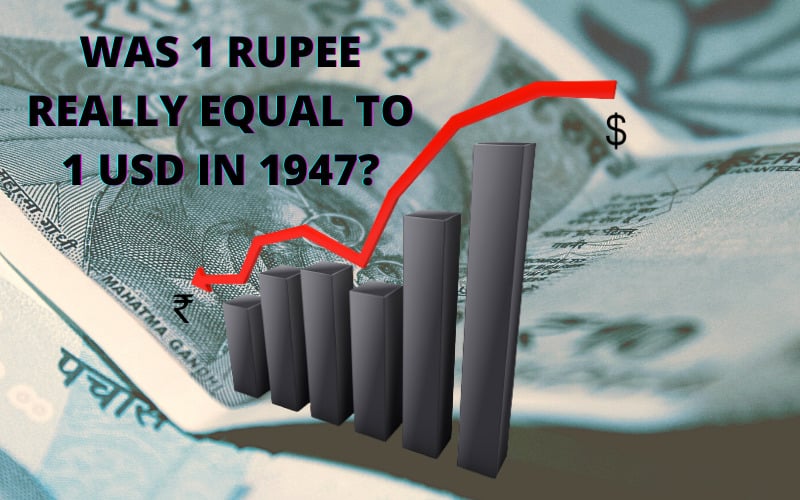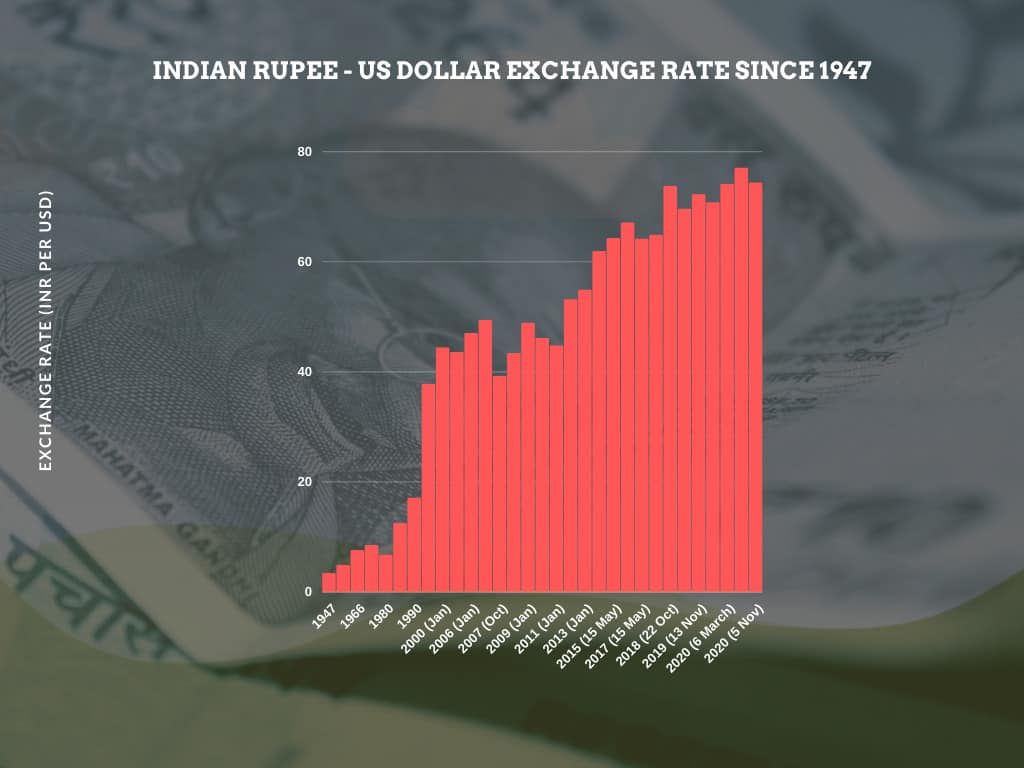
Of late there has been an outrage on social media claiming that you could get 1 USD with 1 INR in 1947 when India became independent.
So ‘was 1 rupee really equal to 1 USD in 1947’? Or was it just a fallacy?
Let us look into this with some facts from history.
The statement cannot be regarded as either true or false.
We have two approaches to this.
1. Approach 1
British regime in India ended in 1947 and the Indian currency then was pegged against the Pound Sterling.
This pegging pattern continued till 1966.
So before USD was taken as the standard global currency, INR was fixed against Pound Sterling.
Now let’s see the exchange rates of INR in 1947 with respect to the Pound Sterling and US Dollar.
| 1 Pound Sterling £1 = Rupees 13.33 (₹)
1 Pound Sterling (£) = USD 4.03 ($) By equating the above 2 we get, $1 = ₹3.03 |
Hence we can conclude that on spending 1 Rupee we could not have bought 1 USD in 1947.
2. Approach 2
India achieved independence on the 15th of August 1947.
It was a new nation with no foreign debt/credit on its national balance sheet.
Thus it can be inferred that Indian rupee was at parity with USD.
Hence by this logic, we can conclude that 1 Rupee was equal to 1 USD in 1947.
The absence of a standard form of currency comparison until 1944 resulted in proving the first argument practical.
Indian Rupee Since 1947
We needn’t explain how powerful the US dollar is. America’s economic world supremacy has made its currency very strong. Most of the other international currencies are pegged against dollars to determine their value on a global level. The volume of business where USD is a part is huge. Also, one of the most recognisable currencies in the whole world is USD.
INR on the other hand is no exception in trading on a global level. Since the independence Rupee has been on a weakening trend.
Let’s see the USD-INR rates from 1947 to 2020
| Year | Exchange rate
(INR per USD) |
| 1947 | 3.30 |
| 1949 | 4.76 |
| 1966 | 7.5 |
| 1975 | 8.39 |
| 1980 | 6.61 |
| 1985 | 12.38 |
| 1990 | 17.01 |
| 1995 (Jan) | 37.69 |
| 2000 (Jan) | 44.31 |
| 2005 (Jan) | 43.50 |
| 2006 (Jan) | 46.92 |
| 2007 (Jan) | 49.32 |
| 2007 (Oct) | 39.14 |
| 2008 (Jan) | 43.30 |
| 2009 (Jan) | 48.82 |
| 2010 (Jan) | 46.02 |
| 2011 (Jan) | 44.65 |
| 2012 (Jan) | 53.06 |
| 2013 (Jan) | 54.78 |
| 2014 (Jan) | 61.86 |
| 2015 (15 May) | 64.22 |
| 2016 (22 Sep) | 67.02 |
| 2017 (15 May) | 64.05 |
| 2018 (9 May) | 64.80 |
| 2018 (22 Oct) | 73.66 |
| 2019 (6 Jan) | 69.53 |
| 2019 (13 Nov) | 72.1512 |
| 2020 (15 Jan) | 70.724 |
| 2020 (6 March) | 74.00 |
| 2020 (21 April) | 76.97 |
| 2020 (5 Nov) | 74.3150 |
Courtesy: Wikipedia
 Graphical representation of Exchange rate of INR per USD
Graphical representation of Exchange rate of INR per USD
The Indian rupee has witnessed many downfalls since 1947. Many geopolitical and economic developments have had direct impacts on Indian rupee in the last 73 years.
1947 – 1971
Indian rupee which was considered at par with dollars in 1947 started to devalue with the introduction of many developmental activities, especially the Five-Year Plan in 1951. As external borrowing was necessary, the government had to devalue INR.
In 1966, India witnessed one of the major financial crises. India was facing a massive trade deficit from 1950 and in 1966 it just got spiked. In addition to the trade deficit, the government was subjected to a budget deficit which made the scenario even more difficult as the government couldn’t borrow money from abroad or the private corporate sector. The government then issued bonds to the RBI, which resulted in inflation.
Furthermore, the Indo-China war in 1962, the Indo-Pakistan war in 1965 worsened the situation resulting in a huge deficit on India’s budget. The drought of 1965/1966 became another reason for Rupee downfall. The government was forced to devalue rupee to Rs 7.5 for 1 $. This exchange rate lasted till 1971.
1971 – 1993
In 1971 INR was officially pegged against the Dollar. In 1975 the value of Indian currency was 8.39 for a dollar. A decade later, in 1985 Indian rupee was devalued again at Rs 12 for 1$.
From 1985 India began to face a balance of payments deficit and in 1991 this issue spiked to a serious economic crisis. India was still on the fixed exchange rate system.
This was a critical situation as India’s foreign reserve could barely meet three weeks of imports. The high inflation rate, budget deficit, all forced the government to devalue the rupee.
In 1992 RBI was low on dollar reserves and found it difficult to maintain the peg and hence the adoption of the floating exchange rate in 1993.
2000 – 2013
From the year 2000-2007 value of rupee was pretty stabilized in the range of Rs 40-48 for a dollar. The rupee hit an all-time high value of Rs 39 for a dollar in late 2007. The major reason that led to the appreciation of Rupee was the sustained inflow of foreign investments to the country. But this trend reversed in late 2008 when the global economic recession materialised. Foreign investments were taken out of the country that led to this depreciation.
Increased imports resulted in a surge in dollar demand in 2013. Also, stagnant reforms and declining foreign investments to the country depreciated the value of rupee in 2013.
2016 – 2020
Demonetisation of currency notes of 500 and 1000 in the year 2016 also led to the depreciation of the rupee in 2016 from Rs 67-71 in the following year.
The year 2020 also witnessed depreciation of the rupee. One significant reason for this was the change of ownership of Yes bank. This has become a matter of concern for investors. Coronavirus pandemic has also affected the performance of INR. The pandemic has created economic uncertainty globally. INR has a negative correlation with crude oil prices as well. As the crude oil price increases, the value of rupee decreases.
Also read: The Secret Behind Who Determines Exchange Rates in India

Roshni Zainaba is a dynamic and creative professional at ExTravelMoney.com, where she expertly manages social media and content creation. With a deep understanding of the travel industry, Roshni specializes in crafting engaging content on topics such as international travel, currency exchange, and international money transfers.
